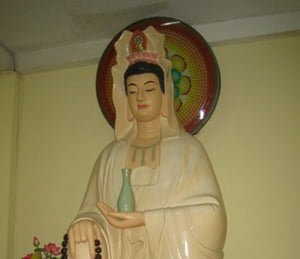
In most Vietnamese Buddhist temples there is a shrine to the monastic ancestors. Normally situated directly behind the main shrine, or in an ante-chamber, these are shrines dedicated to the elder monks and nuns whose lineage the temple monks now represent. Commonly, most of these shrines will contain an image of Bodhidharma, who most Vietnamese Mahayana monks consider their common ancestor. It is also not uncommon to find a photograph of the revered Vietnamese Buddhist Martyr Thich Quang Duc, whose example continues to inspire the Buddhist clergy across every shade of the political spectrum.

These are some images from the Shrine to Monastic Ancestors at Phap Bao Temple near Cabramatta. To find this shrine you have to duck beneath the large statue of the Buddha in the main hall.
The photographs, paintings and calligraphed names of the Patriarchs are quite touching, and I often wonder if anyone at the temple really knows who they all are. I suppose someone must know, in order to have been able to assemble the shrine in the first place.
When a monk joins the religious life he leaves his birth family and joins instead the new family of the Buddha. He abandons all of his old names and takes on the name "Thich" - the first part of Sakyamuni Buddha's name in Vietnamese. And, just as he would have offered prayers and memorials to an ancestor shrine at a private home (and just about every home has one in Vietnam), so he switches his affiliation to this new set of mysterious ancestors, the men (or women, if it is a nun) who represent that particular Buddhist lineage.
It is a rich and fascinating area, and one which I'd like to study more, though I always find it awkward to ask specific questions about the people on the shrines - it seems kind of crass.




